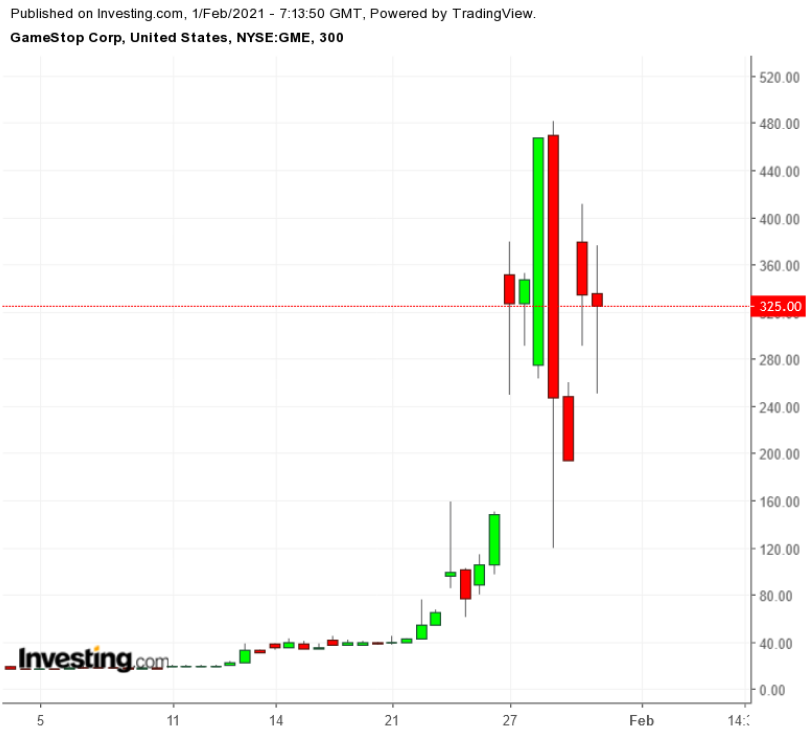There are many ways to interpret GameStop's (NYSE:GME) epic surge in January. It can be viewed as a major battle between small retail investors and the big, establishment guns on Wall Street; it could also be seen as the democratization of investing when the trading proletariat who are active on social media, challenge the financial elite.

But Reddit traders chasing a handful of the most-shorted equity names are also a clear signal of an asset price bubble in markets after a period of historically low interest rates and unprecedented monetary stimulus to fuel the global economy during the pandemic.
Of course, there is no sure way to predict a bubble in the making for any asset class, but there are some fairly similar warning signs that emerge before the value of an asset inflates beyond its realistic worth. Charles Kindleberger, in his classic Manias, Panics, and Crashes, gave the necessary conditions: easy money, and an exciting narrative that will encourage people to invest.
The GameStop frenzy, which pushed the share price of this little-known mall retailer higher by 1,600% this month and forced some hedge funds to book massive losses to cover their short positions, couldn't possibly have happened unless the tens of thousands of average Joe day-traders involved didn't have easy access to liquidity and a lot of time to trade from their bedrooms.
Along with the GameStop drama currently unfolding, there are many other signs that support the argument that markets are in classic bubble territory.
Look at the roller-coaster ride in cryptocurrencies and skyrocketing share prices of clean energy producers. Plus, of course, who could forget the eye-popping rally in Tesla shares (NASDAQ:TSLA) which vaulted more than 720% higher during 2020, while other, small players in the electric-vehicle market also were boosted.
Sell Signal?
The main force creating these bubble-like conditions are governments trying to fight national, pandemic-induced recessions through monetary stimulus. They have spent some $12 trillion in fiscal support alone during the pandemic, according to Bloomberg. At the same time the U.S. Federal Reserve is buying $120 billion of bonds monthly to keep borrowing costs low in the world’s largest economy.
Bank of America strategists warned last week that market excesses could trigger a correction in the first quarter of this year with their Bull & Bear Indicator closing in on a “sell signal.”
“D.C.’s policy bubble is fuelling Wall St.’s asset price bubble,” said the BAC team, led by Michael Hartnett, writing in a note to clients.
“When those who want to stay rich start acting like those who want to get rich, it suggests a late-stage speculative blow-off.”
Analysts at Goldman Sachs said in a note that very high-growth, high-multiple stocks “appear frothy” and the boom in special-purpose acquisition companies (SPACs) is one of a number of “signs of unsustainable excess” in the U.S. stock market. The recent surge in trading volumes of stocks with negative earnings is also at a historical extreme, they said.
How should long-term investors prepare themselves, assuming the market is in bubble, or near-bubble territory?
One straightforward, sensible way is to avoid highly speculative bets, such as GameStop. Another course of action should be to stay away from the areas of the market which are frothy and consider investments that are not in bubble territory, such as financials and some top-rated industrial stocks. Adding exposure to a large-cap dividend fund is another way to add stability and cut risks ahead of a possible market correction.
Bottom Line
It’s hard to predict the end-game on the GameStop, social media fuelled mania. For long-term investors, this presents a warning sign that volatility might spike in the coming days, and it’s a good time to make smaller portfolio changes to moderate the risk. That means increasing exposure to low-volatility assets, boosting cash reserves, and adding assets that have a low or negative correlation with equity markets.
